For this installment of our classic shootout rundown, I thought we would take a look back at the 250 class of 1984.
For this installment of our classic shootout rundown, I thought we would take a look back at the 250 class of 1984.
The early 80’s were an exciting time to be a motocross enthusiast. Motocross technology was moving at an incredible pace and bikes were often being completely redesigned after only ONE YEAR on the market. Can you imagine that today, now that some bikes go half a decade with only small refinements? In the early eighties, change was the norm and complete redesigns were the order of the day. Within the span of three short years, the average 250 MX machines morphed from a simple air-cooled, dual-shocked sled, to a linkage-suspended, liquid-cooled, disc-braked Supercross weapon.
Of course, the flip side of this breakneck pace was the fact that if you were stuck racing a two-year old bike, you were likely left sucking rocks and castor oil. Power plants, suspension and overall design were moving at the speed of light, and this put an incredible strain on the smaller manufacturers. Brands like Can-Am, M-Star (Maico) and Husqvarna were making a valiant attempt to keep pace, but by 1984, the writing was on the wall. The Japanese had set their sights on motocross dominance, and the Old World brands looked to be going down for the count.
For this installment of the test roundup, we are going to look at the shootout results from Motocross Action, Dirt Bike, Dirt Rider and MOTOcross magazine. These were the premier MX focused enthusiast magazines in 1984 and they give us a good cross section of the editorial opinions of the day.
So let’s step into the Way Back Machine one more time and take a look at the 250 motocross class of 1984.
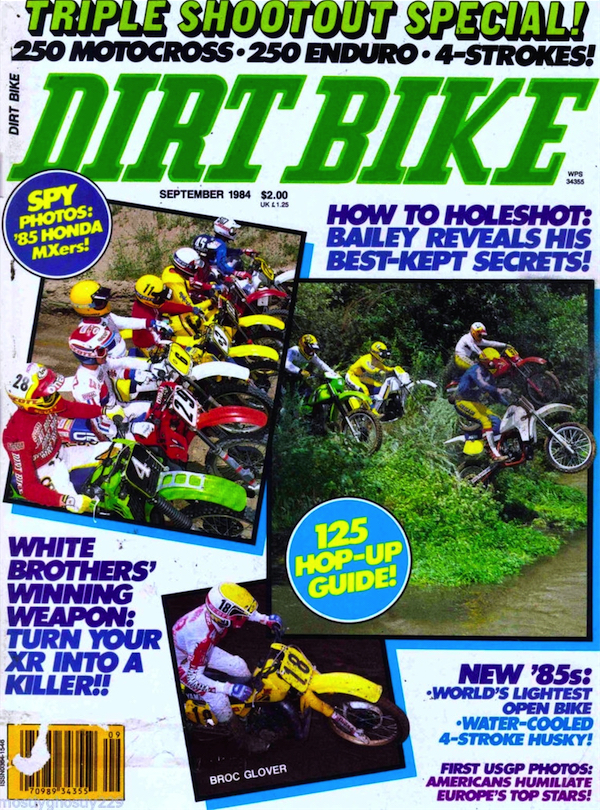 |
|
It is pretty telling that in the four shootouts I looked at in 1984, only the ever-inclusive Dirt Bike Magazine even tested bikes other than the Big Four. MXA, Dirt Rider and MOTOcross magazine all included the Suzuki, Yamaha, Kawasaki and Honda in their tests, but drew the line at the Euro brands. In addition to the usual suspects, Dirt Bike threw in the KTM, Husky and M-Star for good measure. |
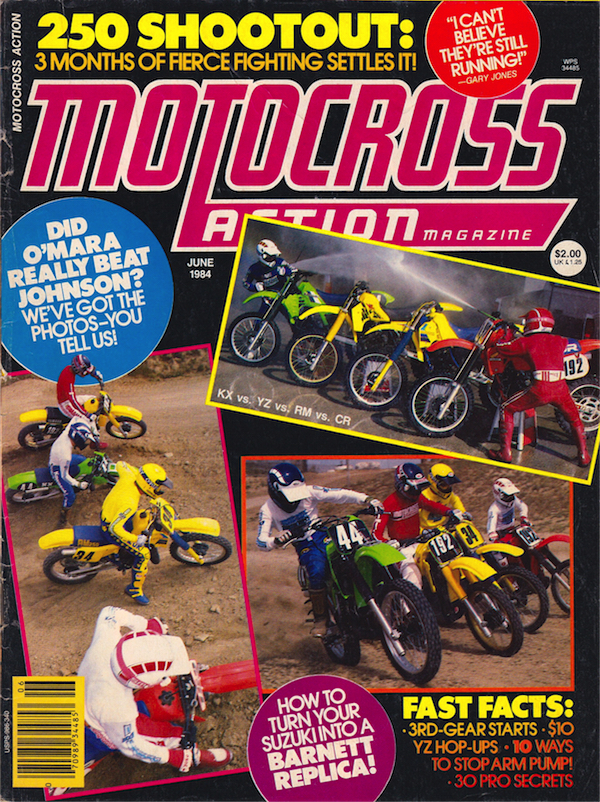 |
|
None of the 1984 250 class were perfect, but MXA came to the conclusion that one machine stood head and shoulders above the rest. |
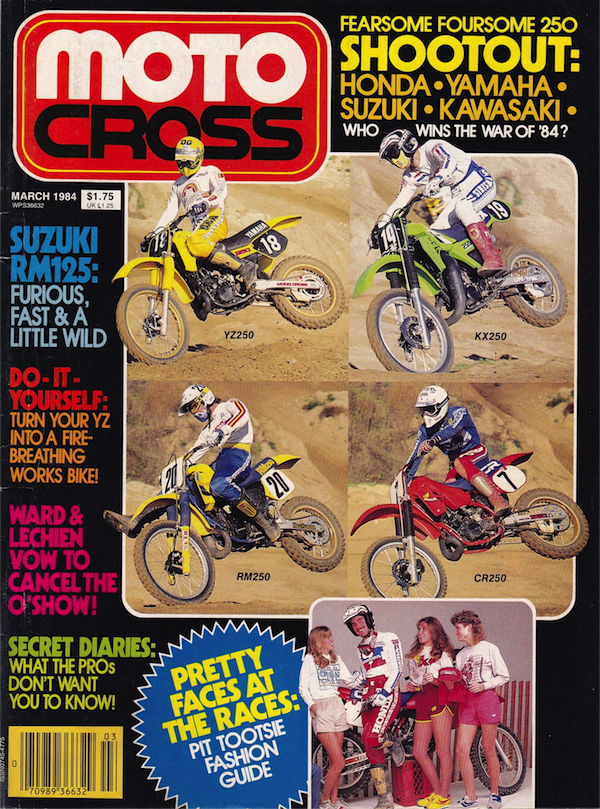 |
|
While the 250 shootout garnered top billing on the cover of the March ’84 issue, I bet most of us teenage moto heads were more interested in the “Pit Tootsie” fashion guide of page 74 |
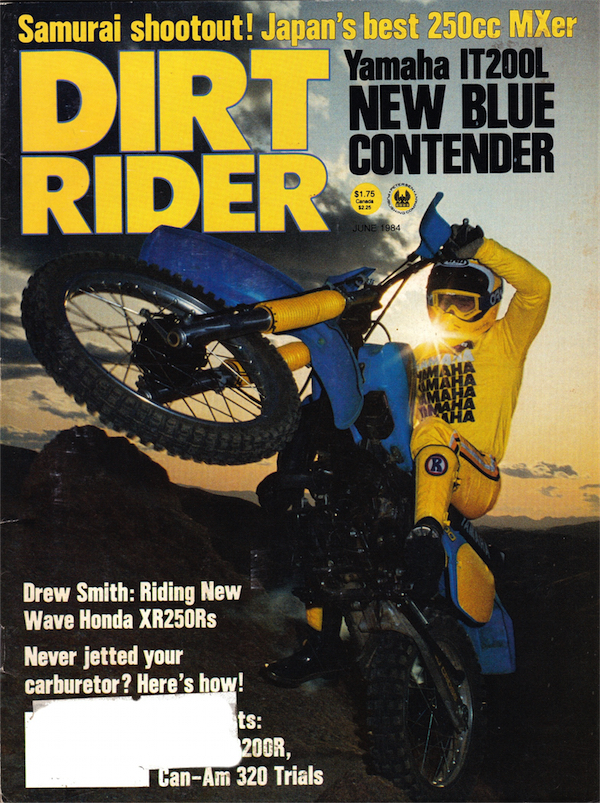 |
|
Dirt Rider magazine was still fairly new in 1984, and their 250 shootout showed that they were still working out the kinks. It was by far the most brief of the four wrap-ups and extremely light on any details. No-pictures, virtually no info and buried in the back of the mag like an afterthought, this shootout garnered a big boo from a fourteen year old Blaze. |
 |
|
1984 Honda CR250R Shootout Ranking – MXA: 1st Dirt Bike: 3rd MOTOcross: 1st Dirt Rider 2nd |
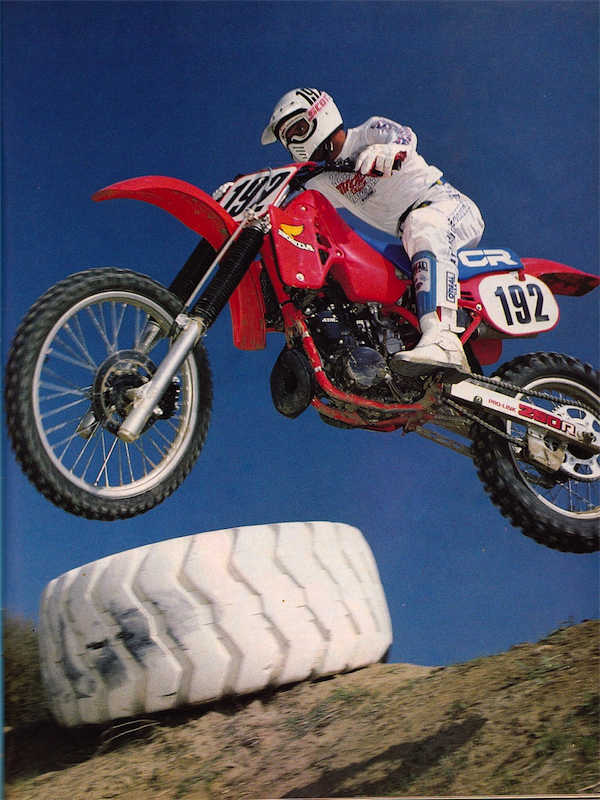 |
|
Overview- For 1984, Honda round-filed their class winning 1983 CR250R and spec’d a virtually all-new machine. The ’84 CR featured Honda’s first production “Power Valve” (dubbed ATAC for Automatic Torque Amplification Chamber) and their first application of a disc brake for the front. New bodywork mimicked the look of the works RC Factory bikes and gave the CR the sleekest lines in the 250 class. On the track, the CR’s new motor romped on the competition with a broad powerband and blistering performance. It was by far the fastest bike of ’84 and head-and-shoulders above the other bikes in stock trim. Unfortunately, the Honda’s suspension was not nearly as effective as the motor and the Red Rooster ranked near the back of the pack in suspension performance. Handling continued to be good overall, with a sharp feel in the turns and a vicious headshake under deceleration. Reliability was also a Honda bugaboo in ’84, with cracked pistons (MXA recommended buying pistons in six-packs), seized crank bearings and broken wheels a major problem. Overall, the Honda was a blazing fast bike, with sano looks and crummy suspension (stop me if you have heard this before). MXA and MOTOcross thought the Honda was best, largely due to its pony prowess, but Dirt Bike and Dirt Rider were less enamored with its propensity to deliver sore wrists, bruised backsides and pricey repair bills. |
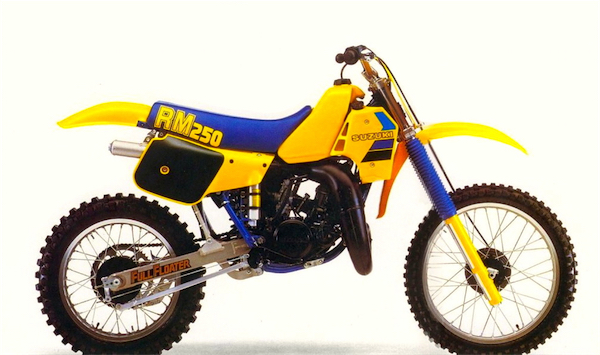 |
|
1984 Suzuki RM250 Shootout Ranking – MXA: 3rd Dirt Bike: 1st MOTOcross: 2nd Dirt Rider: 3rd |
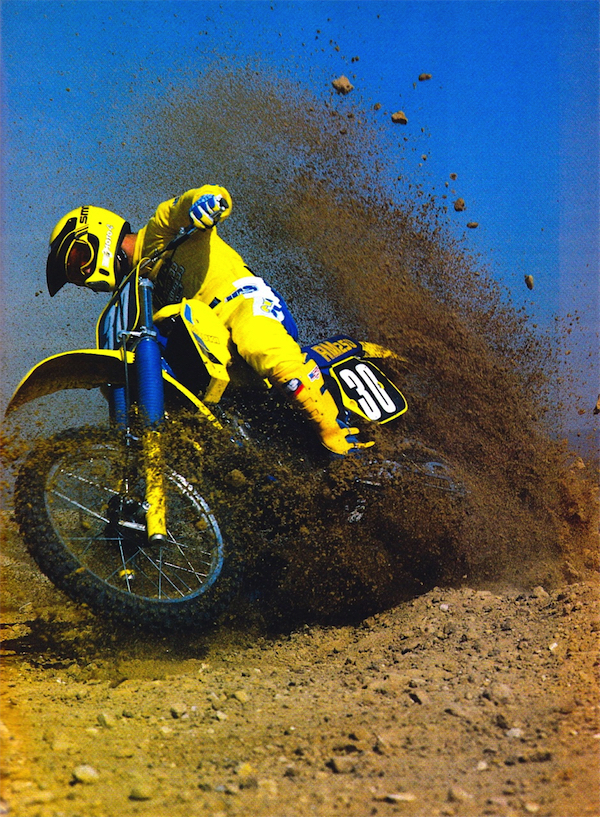 |
|
Overview – Another all-new bike for ’84, the RM250 adopted the looks of the 1983 RH works bikes and added a new coat of bright blue paint to spruce things up. The new bike sported a completely redesigned chassis and a second generation of Suzuki’s award winning Full-Floater rear suspension system. In the motor department, the new bike improved slightly on the mellow (slow) ’83, with a wide spread and pleasant delivery, but no overabundance of thrust. It was an easy to ride power plant, but in no danger of out dragging the torquey Yamaha or blistering Honda. By far the new RM’s greatest virtue was its suspension, which continued to lead the class by a wide margin. In Dirt Bike’s view, this suspension advantage and ease of use outweighed its power deficit. For MXA, Dirt Rider and MOTOcross (who almost picked the RM tops) the RM’s excellent suspension was just not enough to overcome its uninspired power plant. |
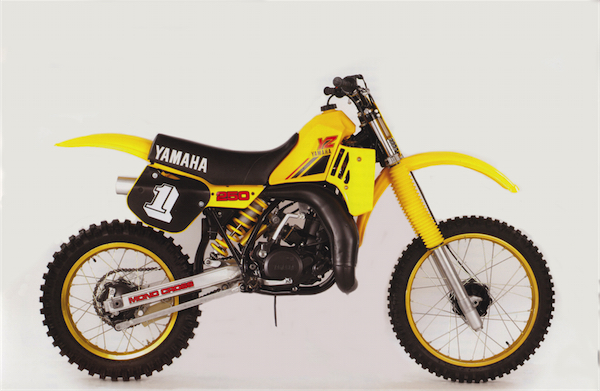 |
|
1984 Yamaha YZ250 Shootout Ranking – MXA: 2nd Dirt Bike: 2nd MOTOcross: 3rd Dirt Rider: 1st |
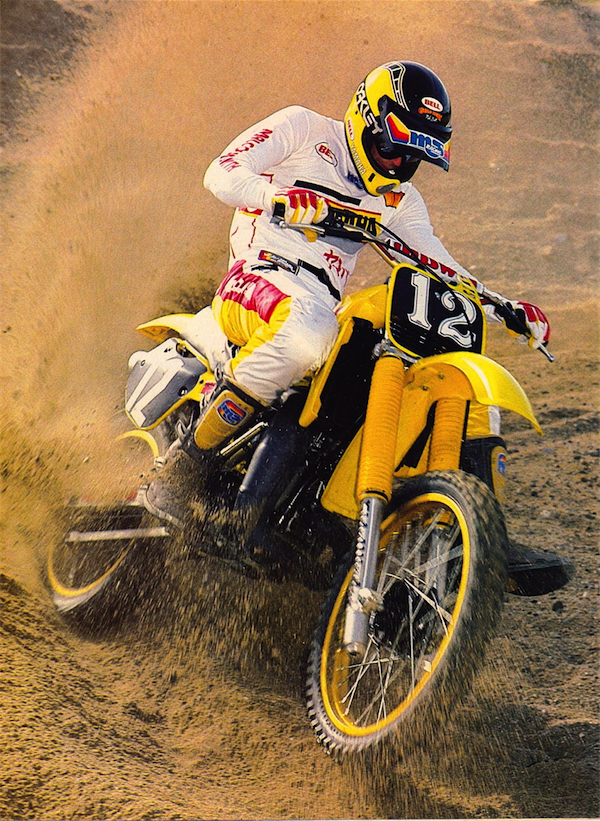 |
|
Overview – A very solid effort for 1984, the YZ was actually good enough to beat out the works bikes of the competition for the 1984 250 National Motocross title. When you consider that Rick Johnson accomplished this feat on basically a stock YZ, with an Öhlins shock, Simons fork and a porting job, it is even more eye opening. In stock condition, the YZ provided a brutal low-end delivery and burly midrange blast. It was the fastest bike out of turns, but once past the midrange, the YZed threw out the anchor. Revving it out only made it go slower, and its cranky transmission made selecting the next cog a chore. The Yamaha handled well, with excellent turning manners and a light feel, but its confused suspension package hindered its performance in the rough. Fork performance was particularly abysmal and more akin to an undersprung pogo stick than a high-tech suspension component. For most of the magazines, the woeful fork performance, cantankerous trans and lack of top-end were enough to knock the YZed out of the top spot. Only Dirt Rider picked it as champ, and only after their CR blew up one too many times. |
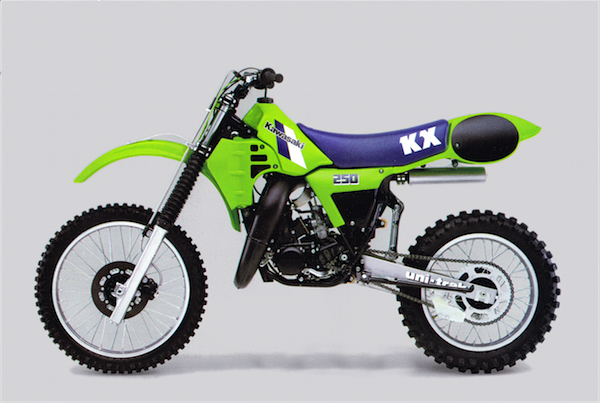 |
|
1984 Kawasaki KX250 Shootout Ranking – MXA: 4th Dirt Bike: 5th MOTOcross: 4th Dirt Rider: 4th |
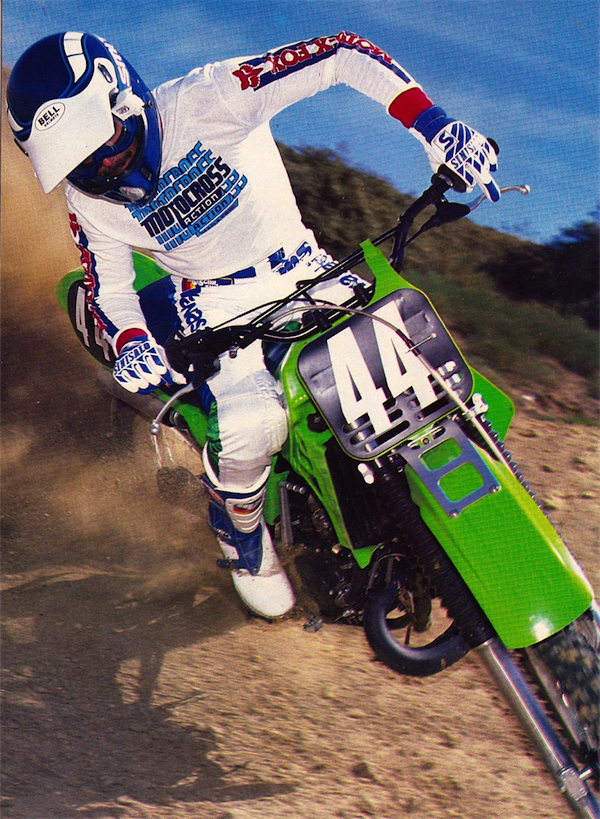 |
|
Overview – The 1984 Kawasaki KX250 certainly does not stand as a high water mark for the green brand. The KX finished last in the three all-Japan shootouts and even got beat out by one of the Euro’s in the Dirt Bike contest. The last of the fender-plated Kwackers, the ’84 KX was burdened with a tall and tippy chassis no one liked and awkward ergonomics that appeared to be designed for Andre The Giant. The bike was clumsy in the corners and by far the hardest of the Nipponese machines to negotiate through the turns. Suspension performance was sup-par, with both ends bottoming out with a mighty thud on anything bigger than a Wrigley’s chewing gum wrapper. Its motor offered decent pull, but the powerband was narrow and hard to use. On the plus side, it did have the most powerful front brake in the class and a trick Euro-style fender brace, so there’s that. Thankfully, better days were ahead for Team Green. |
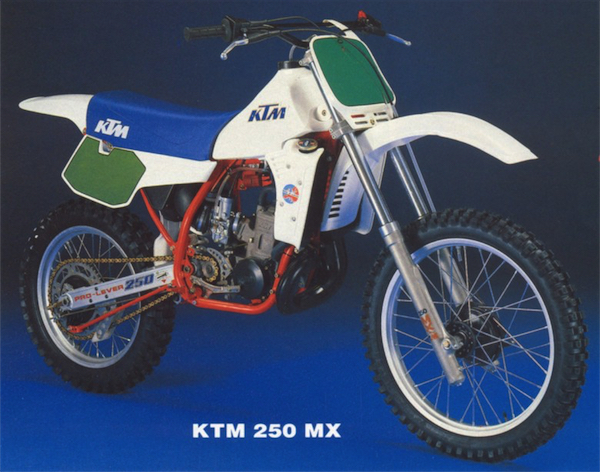 |
|
1984 KTM 250 MX Shootout Ranking – MXA: N/A Dirt Bike: 4TH MOTOcross: N/A Dirt Rider: N/A |
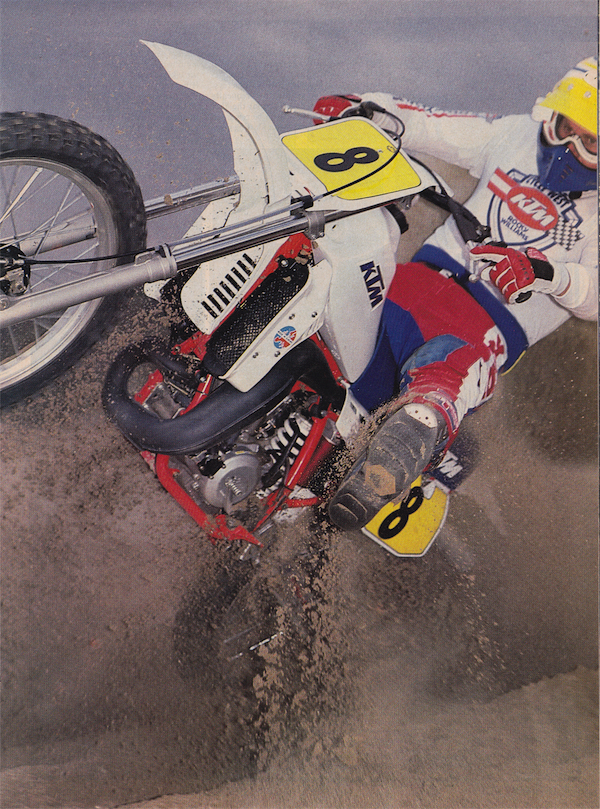 |
|
Overview – In 1984, the KTM 250 actually had a lot going for it. It was the lightest bike in the test at a feathery 213 pounds (no small feat considering the seat was constructed from industrial grade concrete) and over the course of seven months it proved the most reliable. Quality components were used throughout and the KTM’s forged pistons lasted four times that of the cast-formed Japanese competition (ten times in the case of the grenade-prone CR). Power was solid and plentiful (second only to the CR in max output), but the delivery was too slow and enduro-like for most rider’s tastes. The chassis was stable and great for high-speed off-road use (the frame and basic motor were shared across the MX and off-road line), but it felt long and was less enthusiastic in the turns. The suspension was the exact opposite of the mushy Kawasaki, with too much spring rate and too heavy of damping at both ends. Action was brutally harsh and the KTM was rated the worst of the six bikes tested. With some suspension tuning, the KTM made a great off-road mount, but as a motocross machine, it needed a little work. |
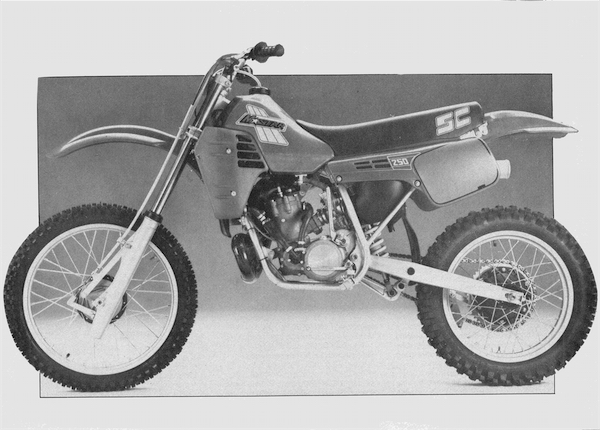 |
|
1984 M-Star 250 SuperCross Shootout Ranking – MXA: N/A Dirt Bike: 5TH MOTOcross: N/A Dirt Rider: N/A |
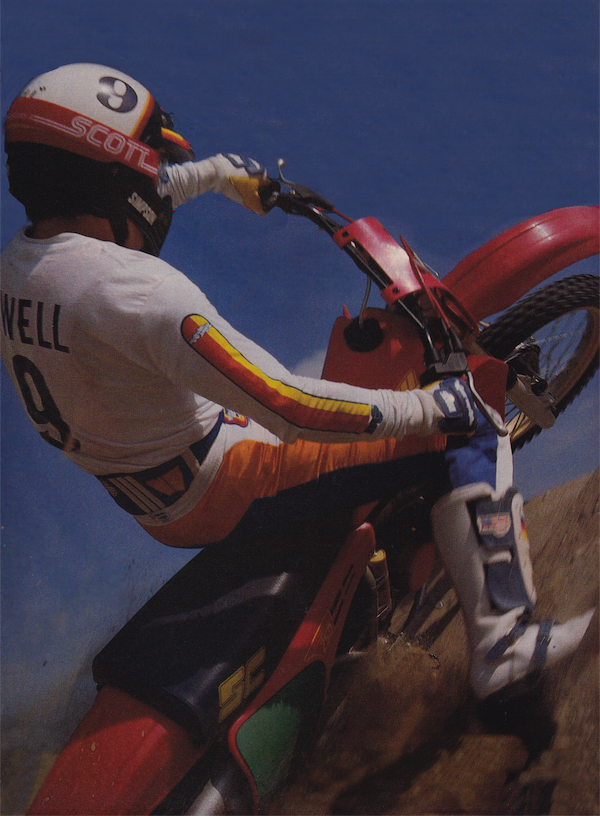 |
|
Overview – Here we have one of the last gasps of a once proud brand, the 1984 M-Star 250 SC (almost comically, the “SC” stood for Supercross, a discipline this bike was not likely to ever experience). In the early eighties, Maico fell on hard times in America and abroad. Product quality issues led to diminishing sales and a string of costly lawsuits crippled the German manufacturer’s finances. As a result, Maicowerk AG filed for bankruptcy in 1983. This understandably left the U.S. distributors less than enthused and when the Maisch brothers in Germany tried to bring back a restructured Maico in 1984, they met with push back from their former partners. The distributors wanted the money they felt they were owed and refused to let Maicos be sold in the US (the distributors owned the rights to the name in America). As a result of this legal wrangling, Maico sought new distributors and was forced to sell the new bikes as a “M-Star” in America. In every other country around the globe, the Maicos remained Maicos, but in the good old USA, we got M-Stars, go figure. As for the quality of the new 250 “SuperCross”, it was actually a pretty decent bike overall. The ’84 250 SC was Maico’s, huh…I mean M-Star’s, first attempt at a liquid-cooled 250 and pretty solid for a first effort from a bankrupt manufacturer. There was no power valve or fancy disc brakes, but the SC featured single shock suspension and modern look. The motor put out a pleasant spread of ponies that pulled well from the midrange up, but the low-end response was pretty poor and bike required a 125-style aggressiveness to keep it on the pipe. In most situations, the M-Star demanded either its rider to be a gear lower than the others, or be willing to fry the clutch mercilessly to get the German percolating. In addition to its lethargic low-end, a grim set of Maico (M-Star?) designed 42mm forks, a poorly set up Öhlins shock and a girthy 231 pound fighting weight (18 pounds porkier than the KTM!) held the Teutonic terror back in the final rankings. In the end, it was only better than one machine in the test. |
 |
|
1984 Husqvarna CR250 Shootout Ranking – MXA: N/A Dirt Bike: 6TH MOTOcross: N/A Dirt Rider: N/A |
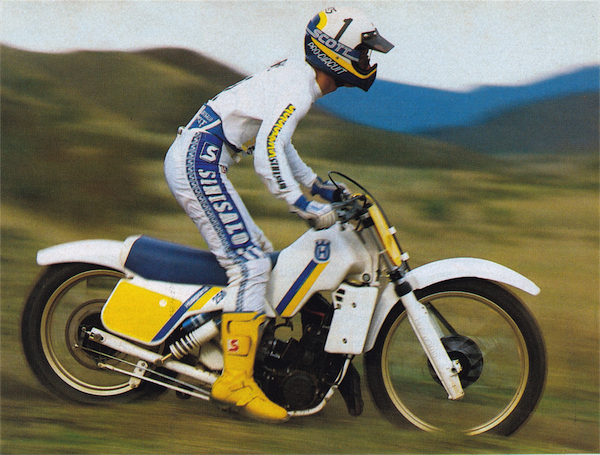 |
|
Overview – Much like its European brethren, Husqvarna was struggling to keep pace with the Japanese in 1984. A full five years after the debut of Kawasaki’s Uni-Trak rising rate, single shock suspension, the Husky was still making due with seventies-era dual shocks in ‘84. They actually worked pretty well (better than the M-Star, Honda, or KTM’s shocks actually), but they gave the bike a very antiquated look and wide layout. Liquid cooling finally made its debut in 1984 on the Hooska, but the new motor still pumped out very old-school dose of ponies. Like the M-Star, the Husqvarna was badly overweight (despite its lack of a beefy swingarm or linkage) and was only one pound lighter than the gravitationally challenged German. On the track, the Swede was the slowest bike in the test by a Nordic mile and incapable of out pulling a well-tuned KX125. It was slow to rev and happier plowing through pine trees than blasting berm shots. The suspension was good, if a bit soft and the bike handled well, as long as turns were not in your vocabulary. Like the KTM, it made a much better off-roader than MX racer and unfortunately, was no threat to the cutting-edge bikes from Japan in 1984. |





